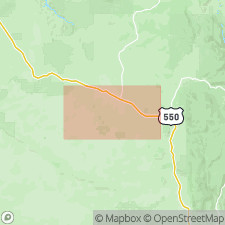
- Usage in publication:
-
- Ojo Encino Member
- Modifications:
-
- Named
- Dominant lithology:
-
- Mudstone
- Sandstone
- Siltstone
- AAPG geologic province:
-
- San Juan basin
Summary:
Here named as middle member of early and late Paleocene Nacimiento Formation (revised) and includes early Paleocene Penistaja Bed (new) at its base. Named for local spring called Ojo Encino (Spanish for Oak Spring), as well as more recently, a Navajo Nation Chapter and boarding school, [all] just west of Torreon Wash (sec 22, T20N, R5W). Type section and extensive fossiliferous exposures nearby along west and east flanks of Torreon Wash at SE1/4 SE1/4 NW1/4 sec 27, T21N, R5W, Deer Mesa 7.5-min quad, south of Kutz Canyon in southern San Juan basin, Sandoval Co, northwestern NM. See also the Nacimiento's composite section and well log correlation (Figs. 5, 9, and 10). Extends to Escavada Wash and Mesa de Cuba (both in Sandoval Co) and to Chico Springs, De-Na-Zin Wash, Betonnie Tsosie Wash, and West Flank Kimbeto Wash (all in San Juan Co), northwestern NM. Outcrops as prominent ledges and cuestas in lower part. At type, consists of 31% mudstone, 36% fine-grained sandstone and siltstone, 22% sandstone, and 11% sandy mudstone. Variegated red and green mudstones interbed with white, trough cross-bedded, fine-grained sandstones and typically overlie and underlie black, highly bentonitic mudstones. At base, the Penistaja is brown to grayish orange. Overall, colorful banding is characteristic of the Ojo Encino. At type, total thickness is 106.1 m; elsewhere in basin, varies from 90 to 122 m. Disconformably overlies (by sharp, scoured contact) early Paleocene Arroyo Chijuillita Member (new) of the Nacimiento. Apparently conformably underlies early and late Paleocene Escavada Member (new) of the Nacimiento. Correlation determined by reading subsurface electric-log signatures in wells and by surface measured sections. Age is early Paleocene (late Danian) based on classic Torrejonian mammal faunas and magnetostratigraphy. Report includes geologic sketch map, correlation charts, field notes, composite sections, well logs, and measured sections.
Source: GNU records (USGS DDS-6; Denver GNULEX).
For more information, please contact Nancy Stamm, Geologic Names Committee Secretary.
Asterisk (*) indicates published by U.S. Geological Survey authors.
"No current usage" (†) implies that a name has been abandoned or has fallen into disuse. Former usage and, if known, replacement name given in parentheses ( ).
Slash (/) indicates name conflicts with nomenclatural guidelines (CSN, 1933; ACSN, 1961, 1970; NACSN, 1983, 2005, 2021). May be explained within brackets ([ ]).

